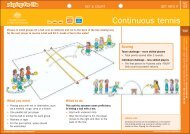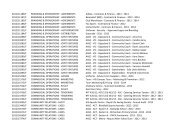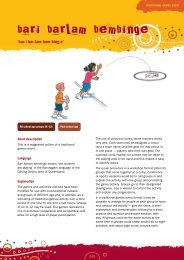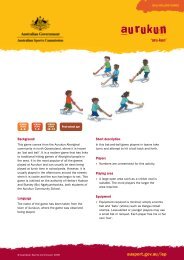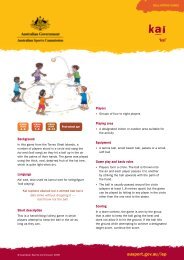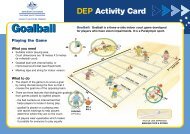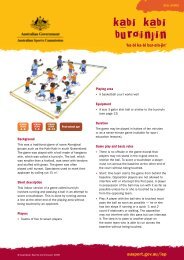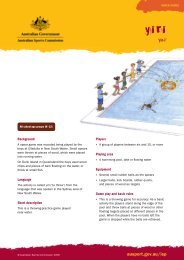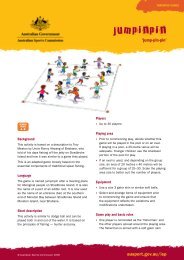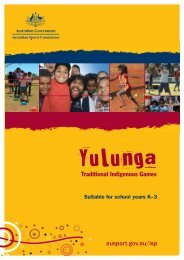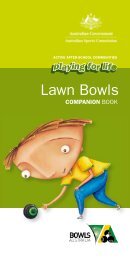the sydney 2000 olympic and paralympic games - Australian Sports ...
the sydney 2000 olympic and paralympic games - Australian Sports ...
the sydney 2000 olympic and paralympic games - Australian Sports ...
You also want an ePaper? Increase the reach of your titles
YUMPU automatically turns print PDFs into web optimized ePapers that Google loves.
PART FOUR : NSW GOVERNMENT AGENCIES GAMES SUPPORT SERVICES<br />
staff implemented ground transport strategies, including liaison with bus <strong>and</strong> o<strong>the</strong>r operational staff to<br />
ensure <strong>the</strong> needs of athletes <strong>and</strong> team officials were properly met.<br />
Paralympic Transport<br />
The special transport needs of <strong>the</strong> Paralympic Games included <strong>the</strong> athletes <strong>and</strong> Paralympic Family, large<br />
numbers of school groups attending events, a unique spectator ticketing system <strong>and</strong> <strong>the</strong> travel patterns of<br />
Sydney returning to normal daily activities.<br />
1.2 million Paralympic tickets were sold; most were undated day passes that could be used on any day.<br />
This presented <strong>the</strong> transport issue of forecasting how dem<strong>and</strong> would be spread across <strong>the</strong> Games, while<br />
also catering for commuter travel <strong>and</strong> return to normal daily activities.<br />
The Olympic Games provided a basic framework for Paralympic Transport, however major changes were<br />
required to meet Paralympic needs. Paralympic transport initiatives included:<br />
• Charter bus parking at SOP to cater for large numbers of school children.<br />
• CityRail ambassadors to meet school groups <strong>and</strong> help with transport arrangements.<br />
• SOP bus routes were scheduled for <strong>the</strong> 5 key days of <strong>the</strong> Games.<br />
• Free rail travel extended to <strong>the</strong> outer points of <strong>the</strong> Sydney suburban network.<br />
• Private parking was permitted at SOP, Dunc Gray Velodrome <strong>and</strong> <strong>the</strong> Sydney International Shooting<br />
Centre for people with disabilities.<br />
• Taxi <strong>and</strong> hire car drop off points were moved closer to venues.<br />
Accessibility was an important consideration during both <strong>the</strong> Olympic <strong>and</strong> Paralympic Games, with low<br />
floor buses acquired to assist people with disabilities. During <strong>the</strong> Olympic Games approximately 100 low<br />
floor buses were used for spectators <strong>and</strong> <strong>the</strong> Olympic workforce, 24 for <strong>the</strong> Athletes Village bus service<br />
<strong>and</strong> at least 8 for <strong>the</strong> Sydney CBD free bus loop. During <strong>the</strong> Paralympics, approximately 70 low floored<br />
buses were used for spectators <strong>and</strong> workforce, 20 buses for services within <strong>the</strong> Paralympic Village <strong>and</strong><br />
130 buses for transport of athletes, officials <strong>and</strong> accredited media to venues.<br />
Games-time Results<br />
There were more than 4.6 million passenger trips by public transport to SOP during <strong>the</strong> Olympic Games,<br />
3.5 million by rail <strong>and</strong> 1.1 million by bus. The weekend commencing Friday 22 September <strong>2000</strong> marked<br />
<strong>the</strong> first days involving <strong>the</strong> biggest two SOP venues, Stadium Australia <strong>and</strong> Sydney Aquatic Centre. There<br />
were 1.2 million passenger trips to SOP over <strong>the</strong> 3 days.<br />
There were more than 1.5 million passenger trips to venues outside SOP, more than 500,000 to Darling<br />
Harbour <strong>and</strong> more than 1 million to <strong>the</strong> Western <strong>and</strong> Eastern Venues. Almost 6 million passenger trips<br />
passed through Central Station, compared to 2.3 million normally.<br />
RTA figures showed that road conditions were improved during <strong>the</strong> Games period, with traffic levels down<br />
15% across Sydney <strong>and</strong> with reductions of up to 24% in peak periods.<br />
More than 6,000 volunteer drivers were recruited <strong>and</strong> trained as part of <strong>the</strong> Australia's biggest ever car<br />
fleet operation. An additional 3,000 non-driving volunteers were managed by ORTA. ORTA's volunteer<br />
drivers worked more than 60,000 shifts, with more than 167,700 trips taken by <strong>the</strong> Olympic car fleet.<br />
During <strong>the</strong> Paralympic Games, <strong>the</strong>re were 1.2 million passenger trips to SOP. More than 6,200 transport<br />
staff were accredited, including 2,210 volunteer car drivers, 720 bus drivers <strong>and</strong> 150 volunteer navigators.<br />
54



